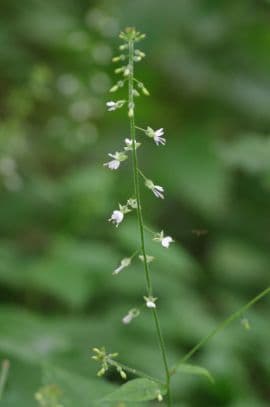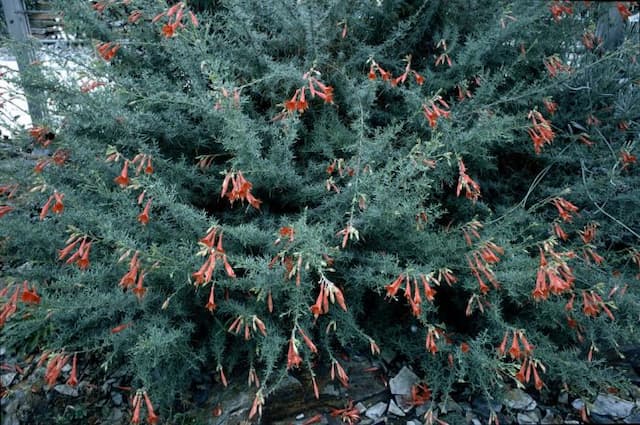Fuchsia Fuchsia 'Finn'

ABOUT
Fuchsia 'Finn' is known for its graceful appearance and striking flowers. This variety showcases dangling blooms that are reminiscent of dainty fairy lanterns. The flowers are bilaterally symmetrical and often display a unique combination of colors, typically with petals that are deep purple and pink in shade. These petals gracefully encircle the stamens and are slightly back-swept, giving the blossoms a balletic poise. The petals may also be complemented by long, trailing sepals that are typically a lighter shade, often a soft pink or sometimes white, forming an elongated tube that gives a contrasting backdrop to the vibrant petals. The sepals and petals together create an effect of depth and richness. The foliage of the Fuchsia 'Finn' consists of dark green leaves with a slight glossy finish, providing a lush backdrop to the vibrant flowers. The leaves have a delicate vein pattern and are ovate with a slight point at the tip, often softly serrated along the edges. The overall growth habit forms a mounded and trailing shape that contributes to its ornamental appeal, making it ideal for hanging baskets and containers where its trailing branches and flowers can elegantly cascade over the sides. The fuchsia plant's habit of producing flowers along the tips of the branches throughout the growing season ensures a long-lasting display of its charming blooms.
About this plant
 Names
NamesFamily
Onagraceae.
Synonyms
Ladies' Eardrops, Fairy Bells, Hummingbird Fuchsia.
Common names
Fuchsia 'Finn'.
 Toxicity
ToxicityTo humans
The Fuchsia, including the 'Finn' variety, is generally considered non-toxic to humans. Ingesting parts of the plant typically does not lead to serious poisoning. However, consuming large amounts might cause mild gastrointestinal discomfort. It is always good practice to avoid eating any part of ornamental plants not meant for consumption.
To pets
The Fuchsia, including the 'Finn' variety, is also generally considered non-toxic to pets such as cats and dogs. While it is not poisonous, ingestion could possibly lead to mild gastrointestinal upset in some pets. If your pet has consumed a large amount and is showing signs of distress, it is recommended to consult a veterinarian.
 Characteristics
CharacteristicsLife cycle
Perennials
Foliage type
Deciduous
Color of leaves
Green
Flower color
Mixed
Height
1-2 feet (30-60 cm)
Spread
1-2 feet (30-60 cm)
Plant type
Shrub
Hardiness zones
9
Native area
Central America
Benefits
 General Benefits
General Benefits- Attractive Flowers: Fuchsia 'Finn' produces beautiful, pendulous flowers that can add visual appeal to any garden.
- Hummingbird Attractor: The plant is known for attracting hummingbirds, which can help with pollination and provide natural entertainment.
- Shade Tolerance: This variety of fuchsia can thrive in partially shaded areas, making it ideal for garden spots that don't receive full sunlight.
- Container Gardening: Fuchsia 'Finn' is well-suited for potting, allowing for decorative versatility on patios, balconies, and indoors.
- Long Blooming Period: It typically has a lengthy blooming season, offering colorful blossoms from late spring to early fall.
- Easy Pruning: The plant responds well to pruning, which can help maintain its shape and promote more vigorous flowering.
- Versatility: Fuchsias can be used in a variety of garden designs, including hanging baskets, borders, and as specimen plants.
- Wide Color Range: Offers a range of flower colors, providing options for various design palettes.
- Relatively Pest-Free: Generally, fuchsias are not prone to serious pest problems, reducing the need for chemical treatments.
 Medical Properties
Medical PropertiesThis plant is not used for medical purposes.
 Air-purifying Qualities
Air-purifying QualitiesThis plant is not specifically known for air purifying qualities.
 Other Uses
Other Uses- Living Art: Fuchsia plants, with their beautiful hanging flowers, are often trained into unique living art forms, such as bonsai or topiaries, which can serve as captivating conversation pieces in garden displays.
- Garnish: The fuchsia's vivid flowers can be used to garnish salads, desserts, and cocktails, adding a splash of color and a touch of sophistication to the presentation of dishes.
- Natural Dyes: The petals of fuchsia flowers can be used to create a natural dye for fabrics or paper, offering a range of pinks and purples depending on the mordant used.
- Fairy Gardens: Small fuchsia varieties can be incorporated into fairy gardens, providing a whimsical touch with their delicate flowers that can resemble tiny ballerinas.
- Photography: Fuchsias can be a stunning subject for macro and close-up photography due to their intricate flower structure and the contrast between their petals and stamens.
- Butterfly and Hummingbird Attraction: Planting fuchsias in the garden can attract hummingbirds and butterflies, which are drawn to their nectar-rich flowers, thereby supporting local biodiversity.
- Educational Tool: Fuchsias can be used in educational settings to teach about plant biology, pollination, and the importance of horticulture in maintaining vibrant ecosystems.
- Floral Arrangements: With their drooping blossoms, fuchsias can add an exotic touch and vertical interest to floral arrangements and bouquets.
- Edible Crafts: The edible fuchsia flowers can be used in creating delicate sugarcraft for decorating cakes and pastries, providing an edible element that's as beautiful as it is tasty.
- Theme Gardens: Fuchsias can play a starring role in Victorian-themed gardens, which focus on the opulence and diversity of plant life during the Victorian era.
Interesting Facts
 Feng Shui
Feng ShuiThe Fuchsia is not used in Feng Shui practice.
 Zodiac Sign Compitability
Zodiac Sign CompitabilityThe Fuchsia is not used in astrology practice.
 Plant Symbolism
Plant Symbolism- Confiding Love: Fuchsia's delicate hanging blossoms can symbolize confiding love, representing trust and intimacy in relationships.
- Good Taste: With its elegant appearance, fuchsia is often associated with good taste and sophistication in life and in aesthetic choices.
- Amiability: The fuchsia plant, known for its congeniality, is usually linked to amiability and a warm, welcoming nature.
- Overflowing Abundance: The profusion of flowers that fuchsia plants often produce can symbolize overflowing abundance, generosity, and a richness of spirit or resources.
 Water
WaterFuchsia 'Finn', commonly known as fuchsia, requires consistent moisture. It's best to water the plant deeply once the top inch of soil feels dry to the touch, which typically means watering a couple of times a week. However, the frequency can vary depending on environmental conditions, such as temperature and humidity. Use room temperature water and gently water at the base of the plant to avoid splashing the leaves, which can encourage disease. During active growth in spring and summer, a fuchsia may need approximately one gallon of water per week, but always check the soil moisture before watering to avoid overwatering.
 Light
LightFuchsia 'Finn' thrives in bright, indirect light. It should be placed where it is shielded from the harsh rays of the midday sun, which can scorch the leaves. Morning sunlight or dappled light is ideal for this plant. If grown outdoors, a fuchsia prefers a spot that receives morning sun and afternoon shade to maintain vibrant foliage and abundant blooms.
 Temperature
TemperatureFuchsia 'Finn' typically grows best in cooler temperatures, between 55°F and 75°F. It's important to protect the plant from extreme temperatures, as it can suffer damage in temperatures below 40°F or above 80°F. The ideal temperature for this fuchsia variety is around 65°F for optimal growth and flowering.
 Pruning
PruningPruning fuchsia 'Finn' is essential to encourage bushy growth and more flowers. Prune in late winter or early spring before new growth begins by cutting back the previous year's growth by about a fourth. Throughout the growing season, pinch out the tips of stems to promote branching and deadhead spent flowers to maintain a tidy appearance and encourage continuous blooming. The best time for major pruning is just before the plant resumes growth after the last expected frost.
 Cleaning
CleaningAs needed
 Soil
SoilThe best soil mix for the hardy Fuchsia 'Finn' is a well-draining light potting mix with peat moss and perlite, ensuring moisture retention without waterlogging. The ideal soil pH for this plant ranges from 6.0 to 7.0 for optimal growth. Regular feeding with a balanced fertilizer during the growing season will help maintain its health.
 Repotting
RepottingHardy Fuchsia 'Finn' should be repotted every two to three years to refresh the soil and accommodate root growth. The best time to repot is in the late winter or early spring before the new growth begins.
 Humidity & Misting
Humidity & MistingFuchsia 'Finn' thrives in moderate humidity levels, ideally between 60-70%. Consistently high humidity can promote lush growth and vibrant blooms, while avoiding excessively dry air that can stress the plant.
 Suitable locations
Suitable locationsIndoor
Place hardy Fuchsia 'Finn' in bright, indirect light indoors with good air circulation.
Outdoor
Grow hardy Fuchsia 'Finn' in part shade, sheltered from harsh sun and winds.
Hardiness zone
6-9 USDA
 Life cycle
Life cycleThe Fuchsia 'Finn', commonly known as Fuchsia, starts its life cycle when the seeds are sown in a moist, well-drained soil mix, often in the spring. The seedlings emerge and gradually develop into young plants with characteristic opposite leaves and a bushy growth habit. As the plants mature, they begin to produce distinctive pendant flowers, usually in the summer, which can range in color from pink to purple and have a unique, teardrop shape. During the flowering phase, they attract hummingbirds and pollinating insects which help in the reproduction process. After pollination, the flowers are followed by small, berry-like fruits that contain seeds for the next generation. In temperate regions, Fuchsia 'Finn' may go dormant in the winter, losing its leaves, and requires pruning before returning to the active growth phase in the spring.
 Propogation
PropogationPropogation time
Spring-Early Summer
The Fuchsia 'Finn', commonly referred to as Hard Fuchsia, is typically propagated during the spring or early summer. The most popular method is through stem cuttings. To do this, a healthy, non-flowering shoot is selected and cut, making the cutting about 2-4 inches (5-10 cm) long. It is important to make a clean cut just below a leaf joint. The lower leaves of the cutting are removed, and the cut end is dipped in rooting hormone to encourage root development. The cutting is then placed in a pot filled with a mix of peat and perlite, ensuring at least two leaf nodes are submerged. The pot is kept in a warm place with indirect light, and the soil is kept moist but not waterlogged. Roots typically develop within three to four weeks, after which the young plants can be potted in a more substantial soil mix to continue growing.









